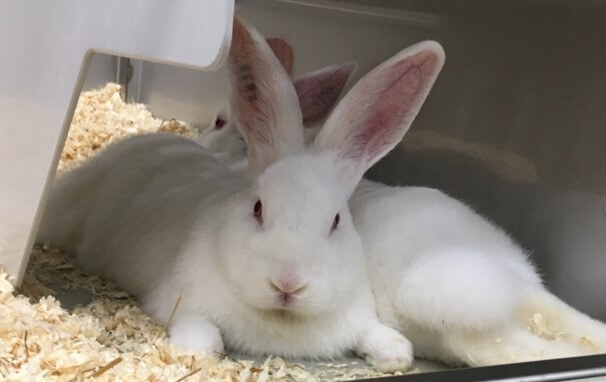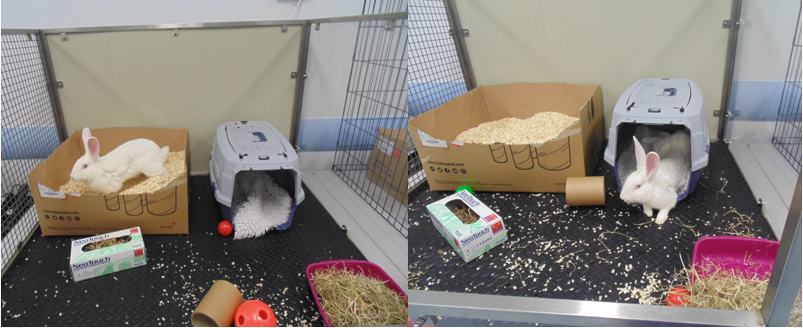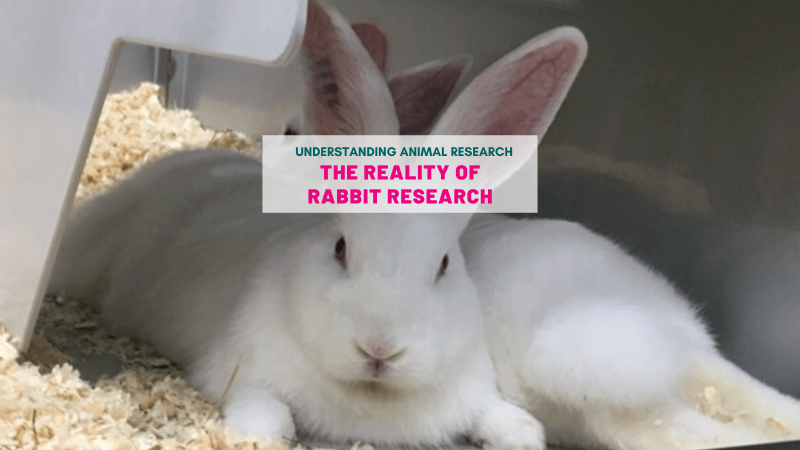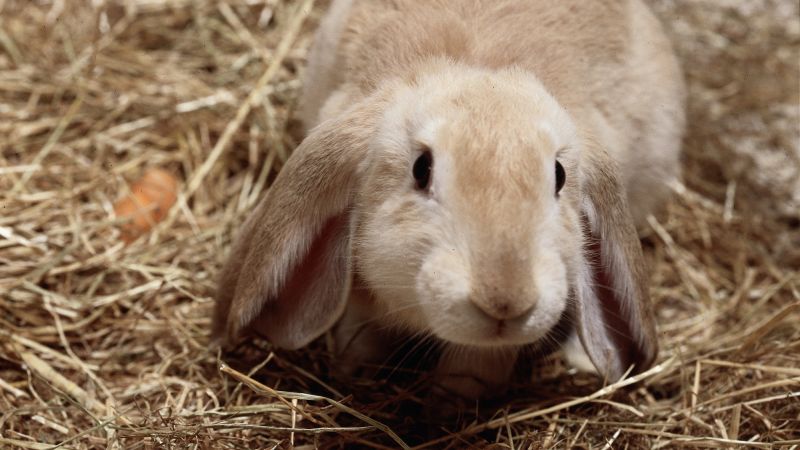
Rabbits (Oryctolagus cuniculus) belong to the order Lagomorphia and family Leporidae, which also includes their closely related cousin the hare. Rabbits are medium-sized mammals that can grow to 50cm and 4.5kg in size, depending on the breed. Rabbits are herbivores, their diet consists mostly of grass, clover, and cruciferous plants. In captivity, rabbits are mainly fed dried hay, pelleted food, and a small but regular amount of fresh vegetables. Rabbits are not used very often in scientific research in Great Britain where they are involved in roughly 2.5% of experiments (more detailed statistics can be found here).
Why are rabbits used in research?
Although rabbits are not commonly used in research, they can be very useful. When trained well and handled from a young age, rabbits are often docile and respond well to the laboratory environment. They are relatively easy to breed, which means they don’t have to be subjected to invasive procedures, and they have a naturally short lifespan which makes them useful for studies into reproduction, ageing processes, and physical development amongst others.
Are rabbits used to test cosmetic products?
It is illegal to test cosmetic products on animals in the UK. No animals have been used for cosmetic testing in the UK since 1998. Historically, rabbits were used to test the safety of cosmetic products and images from those tests are still sometimes reproduced giving the misleading impression that these procedures continue to take place. A complete ban on using all vertebrate animals to test cosmetics - which includes rabbits, of course - came into force across the EU in 2013. The UK ban on cosmetic testing remains in place after Brexit. . You can read more about cosmetic testing on animals here.
What types of research are rabbits used in?
Rabbits are most often used in the production and research of antibodies. The animals are genetically altered in order to produce antibodies that that can be used in humans or to study human disease. The Rabbit immune system is able to recognise a much broader diversity of antigens compared to rodents such as mice and rats. Rabbits are also much larger animals and therefore capable of producing greater quantities of antibodies without harm to the animal. Rabbits have been shown to generate antisera containing a high concentration of antibodies, with increased sensitivity and affinity towards a defined target. Several diseases have benefitted from antibody production and research using rabbits, including treatments for Covid-19, the disease caused by SARS-Cov-2.

Rabbits were the first animal models for studying atherosclerosis, the build-up of fats, cholesterol and other substances in artery walls. Rabbits are sensitive to a high cholesterol diet and respond in a similar way to humans, which makes them a useful model for atherosclerosis research. Both normal and genetically altered rabbit models of atherosclerosis are used to research the disease and look for new treatment areas.
Historically, rabbits were used to develop Louis Pasteur’s rabies vaccine. Today they still play a fundamental role in fighting infectious diseases. The physiology of rabbits is similar to humans and rabbits suffer from many diseases with human equivalents. For example, young rabbits often die from a disease called mucoid enteritis, which has aspects in common with the human diseases cystic fibrosis and cholera.
Rabbits were also vital to the discovery and study of the human papillomavirus (HPV) which causes cervical cancer. It was the observation and discovery of the cottontail rabbit papillomavirus (CRPV), by Richard Shope in 1933, that led to the discovery of how HPV causes cervical cancer in humans.
Studies in rabbits remain key in many aspects of medical research, including cancer, glaucoma, ear infections, eye infections, skin conditions, diabetes, and emphysema.
How are rabbits looked after in the laboratory?
The use of animals in research is highly regulated and an important part of that regulation is ensuring the animals are housed and cared for correctly. Over the years, the welfare of animals kept in labs for scientific purposes has vastly improved. Today, a lot of thought goes into the care of all research animals with special attention being paid to each species and their unique requirements. A team of animal carers, commonly known as animal technicians, makes sure that each and every animal’s physiological needs are met within the framework of the animal experiments that are pursued.
Rabbits are social animals that need room to exercise. “The image of the rabbit stuck in the cage is very much an outdated one,” according to the named information officer (NIO) at the University of Surrey. At the University of Surrey, the rabbits are kept in social groups and housed in floor pens with soft bedding and various enrichment activities to stimulate the animals. The rabbits are given dried vegetable bites to nibble on, tunnels to race into and hide, hay that they can eat, burrow into and play with, different beddings to forage and cardboard that they can shred and keep busy with. Read more about rabbit research at the University of Surrey in “The reality of rabbit research”.
Rabbits are intelligent and inquisitive animals that require plenty of mental stimulation and a varied and enriched environment. They are social animals that would almost always live in groups in the wild and therefore they are housed in pairs or groups wherever possible in the laboratory. Some exceptions may occur, such as when an animal is recovering from surgery, where temporary isolation may be required.

Rabbit enrichment playpen © University of Leicester 2021
In the photo above you can see an example of a rabbit enrichment playpen. An enrichment playpen provides animals with opportunities to carry out their natural and instinctual behaviours through a range of activities. Enrichment activities that are suitable for rabbits in the lab include chew toys, digging boxes, and foraging toys.
Enrichment in the lab is provided in a similar fashion to other captive animal settings (zoos, pet shops, sanctuaries etc.). However, hygiene and the avoidance of cross-contamination is especially important in the laboratory so all enrichment, items must be single use or durable enough to be sterilised in an autoclave.
Training animals in the laboratory
Animals used in laboratories are bred for purpose, in part to ensure that they are genetically consistent and have been raised in a pathogen-free environment, but also to reduce the amount of stress the animals experience. Because they have been raised in the laboratory since birth, research animals are familiar with the environment and habituated to life in the laboratory. All animals in the lab will undergo a period of habituation where they are slowly introduced to being handled by humans and get used to being moved from cage to cage when cleaning is required or for other day-to-day activities in the lab. Some animals will be trained to accept procedures such as blood tests and injections, through the use of rewards. Negative reinforcement methods of training should never be used in the laboratory, the majority of animal welfare scientists would discourage the use of negative reinforcement on any animal, whether that be in the lab, at home, or in a commercial setting.
“We use positive reinforcements in the research settings so the rabbits are, for example, eager to step on scales or trolleys to get treats, or comfortable around loud noises,” explains the Named Animal Care and Welfare Officer at the University of Surrey. “Taking the time to get the animals used to the context of the experiments is helpful for the animals who are more relaxed and comfortable, and for the scientist that is working with compliant animals.”
Find out more about the care and welfare of rabbits in UK scientific research on the NC3R's website "Housing and husbandry: rabbits".
Find out more about rabbits in research with our 10 facts infographic.
See also AnimalResearch.info on rabbits, and our video of rabbits.
References:
Housing: https://ori.hhs.gov/education/products/ncstate/rabbit.htm
Why Rabbits in research: https://www.ncbi.nlm.nih.gov/pmc/articles/PMC3283968/
Number of rabbits used in research: https://www.understandinganimalresearch.org.uk/news/animal-research-numbers-2020
Rabbits background: https://www.livescience.com/28162-rabbits.html
COVID antibodies: https://stm.sciencemag.org/content/12/550/eabc3539
Rabbits in atherosclerosis: https://www.ncbi.nlm.nih.gov/pmc/articles/PMC5868506/





